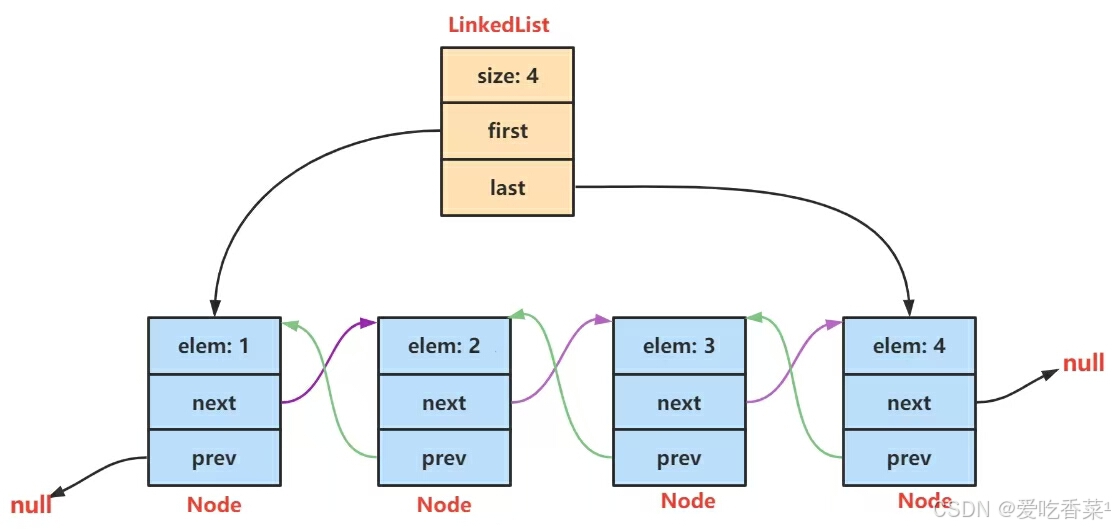【数据结构】LinkedList与链表
目录
链表
1、链表的概念及结构
2、LinkedList的使用
2、1什么是LinkedList
2、2LinkedList的使用
3、LinkedList的遍历
4、LinkedList的模拟实现
5、ArrayList和LinkedList的区别
上篇已经熟悉了ArrayList的使用,ArrayList底层使用数组来存储元素。由于其底层是一段连续空间,当在ArrayList任意位置插入或者删除元素时,就需要将后序元素整体往前或者往后搬移,时间复杂度为O(n),效率比较低,因此ArrayList不适合做任意位置插入和删除比较多的场景。
因此,java集合中又引入了LinkedList,即链表结构。
链表
1、链表的概念及结构
链表 是一种 物理存储结构上非连续 存储结构,数据元素的 逻辑顺序是通过链表中的引用链接次序实现的 。

实际中链表的结构非常多样,以下情况组合起来就有 8 种链表结构:
链表大分类
- 单向或者双向
- 带头或者不带头
- 循环或者非循环
虽然有这么多的链表的结构,但是我们重点掌握两种 :
无头单向非循环链表 : 结构简单 ,一般不会单独用来存数据。实际中更多是作为 其他数据结构的子结构 ,如 哈希桶、图的邻接表等等。另外这种结构在笔试面试 中出现很多。
无头双向链表 :在 Java 的集合框架库中 LinkedList 底层实现就是无头双向循环链表。
2、LinkedList的使用
2、1 什么是LinkedList
LinkedList官方文档
LinkedList的底层是双向链表结构( 链表后面介绍 ) ,由于链表没有将元素存储在连续的空间中,元素存储在单独的节 点中,然后通过引用将节点连接起来了,因此在在任意位置插入或者删除元素时,不需要搬移元素,效率比较高。

在集合框架中,LinkedList也实现了List接口,具体如下:

【说明】
- LinkedList实现了List接口
- LinkedList的底层使用了双向链表
- LinkedList没有实现RandomAccess接口,因此LinkedList不支持随机访问
- LinkedList的任意位置插入和删除元素时效率比较高,时间复杂度为O(1)
- LinkedList比较适合任意位置插入的场景
2、2 LinkedList的使用
LinkedList 的构造
| 方法 | 解释 |
| LinkedList ( ) | 无参构造 |
| Public LinkedList ( Collection<? extends E> c ) | 使用其他集合容器中元素构造List |
public static void main ( String [] args ) {// 构造一个空的 LinkedListList < Integer > list1 = new LinkedList <> ();List < String > list2 = new java . util . ArrayList <> ();list2 . add ( "JavaSE" );list2 . add ( "JavaWeb" );list2 . add ( "JavaEE" );// 使用 ArrayList 构造 LinkedListList < String > list3 = new LinkedList <> ( list2 );}
LinkedList常用方法
| 方法 | 解释 |
| boolean add (E e) | 尾插 e |
| void add(int index, E element) | 将 e 插入到 index 位置 |
| boolean addAll(Collection<? extends E> c) | 尾插 c 中的元素 |
| E remove (int index) | 删除 index 位置元素 |
| boolean remove(Object o) | 删除遇到的第一个 o |
| E get(int index) | 获取下标 index 位置元素 |
| E set(int index, E element) | 将下标 index 位置元素设置为element |
| void clear() | 清空 |
| boolean contains(Object o) | 判断 o 是否在线性表中 |
| int indexOf(Object o) | 返回第一个 o 所在下标 |
| int lastIndexOf(Obeject o) | 返回最后一个o 所在下标 |
| List<E> subList(int fromIndex, int toIndex) | 截取部分 list |
以上就是 LinkedList常用方法 ,需要多练熟悉用法
3、LinkedList的遍历
LinkedList 的遍历有三种;for循环 + 下标、 foreach 、使用迭代器
LinkedList<Integer> list1=new LinkedList<>();list1.add(1);list1.add(2);list1.add(3);list1.add(4);
1、for循环遍历
for (int i = 0; i <list1.size() ; i++) {System.out.print(list1.get(i)+" ");}System.out.println(" ");2、foreach遍历
for (Integer i:list1){System.out.print(i+" ");}System.out.println(" ");3、使用迭代器遍历---正向遍历
ListIterator<Integer> it= list1.listIterator();while(it.hasNext())System.out.print(it.next()+" ");System.out.println(" ");4、使用反向迭代器---反向遍历
ListIterator<Integer> rit= list1.listIterator(4);while(rit.hasPrevious())System.out.print(rit.previous()+" ");System.out.println(" ");}4、LinkedList的模拟实现
模拟实现 LinkedList链表。
public class MyLinkedList {static class ListNode{public int val;public ListNode next;public ListNode prev;public ListNode(int val) {this.val = val;}}public ListNode head;public ListNode last;//头插法public void addFirst(int data){ListNode node=new ListNode(data);if(head==null) {head = last = node;return;}node.next=head;head.prev=node;head=node;}//尾插法public void addLast(int data){ListNode node=new ListNode(data);if(head==null) {head = last = node;return;}last=head;while(last.next!=null){last=last.next;}last.next=node;node.prev=last;last=last.next;}//任意位置插入,第一个数据节点为0号下标public boolean addIndex(int index,int data){int len=size();if(index<0||index>len) {System.out.println("index位置不合法");return false;}if(index==0) {addFirst(data);return true;}if(index==len) {addLast(data);return true;}ListNode cur=findnode(index);ListNode node=new ListNode(data);node.next=cur;cur.prev.next=node;node.prev=cur.prev;cur.prev=node;return true;}private ListNode findnode(int index){ListNode cur=head;while(index!=0){index--;cur=cur.next;}return cur;}//查找是否包含关键字key是否在单链表当中public boolean contains(int key){ListNode cur=head;while(cur!=null){if(cur.val==key)return true;cur=cur.next;}return false;}//删除第一次出现关键字为key的节点public void remove(int key){ListNode cur=head;while(cur!=null){if(cur.val==key){if(cur==head){head=head.next;if(head==null)return;}else {cur.prev.next=cur.next;if(cur.next==null){last=last.prev;}else{cur.next.prev=cur.prev;}}return;}cur=cur.next;}}//删除所有值为key的节点public void removeAllKey(int key){ListNode cur=head;while(cur!=null){if(cur.val==key){if(cur==head){head=head.next;if(head!=null)head.prev=null;}else{cur.prev.next=cur.next;if(cur.next==null){last=last.prev;}else{cur.next.prev=cur.prev;}}}cur=cur.next;}}//得到单链表的长度public int size(){int count=0;ListNode cur=head;if(head==null)return 0;while(cur!=null){count++;cur=cur.next;}return count;}public void display(){ListNode cur=head;if(head==null)return;while(cur!=null){System.out.print(cur.val+" ");cur=cur.next;}System.out.println(" ");}public void clear(){ListNode cur=head,curN=head;while(cur!=null){curN=cur.next;cur.next=null;cur.prev=null;cur=curN;}head=last=null;}}5、ArrayList和LinkedList的区别
| 不同点 | ArrayList | LinkedList |
| 存储空间上 | 物理上一定连续 | 逻辑上连续,物理上不一定连续 |
| 随机访问 | 支持O(1) | 不支持 O ( n ) |
| 头插 | 需要搬移元素,效率低 O( n ) | 只需修改元素指向,时间复杂度 O(1) |
| 插入 | 空间不够可以扩容 | 没有容量概念 |
| 应用场景 | 元素高效存储+频繁访问 | 任意位置插入和频繁删除 |
【数据结构】LinkedList与链表学习到这里
